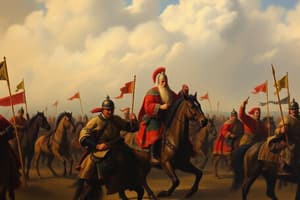Podcast
Questions and Answers
What was a key characteristic of Mongol society regarding state structures?
What was a key characteristic of Mongol society regarding state structures?
- A focus on maritime trade and naval power.
- Strong, defined state structures similar to settled empires.
- Highly centralized bureaucratic systems.
- Lack of strong state structures, relying on clan and family loyalties. (correct)
What military advantage did the Mongols gain from using mounted archery and stirrups?
What military advantage did the Mongols gain from using mounted archery and stirrups?
- Improved close-combat effectiveness.
- Enhanced ability to construct siege weaponry.
- Better defense against naval attacks.
- Greater control and maneuverability on horseback. (correct)
How did Mongols typically engage in combat, preferring to resolve conflicts?
How did Mongols typically engage in combat, preferring to resolve conflicts?
- By directly engaging in close-quarters combat.
- By pelting enemies with arrows from a distance until they gave up. (correct)
- Through prolonged sieges of fortified cities.
- By using heavy infantry formations to break enemy lines.
What role did Ogedai play in the Mongol empire?
What role did Ogedai play in the Mongol empire?
What was the significance of the Yuan Dynasty?
What was the significance of the Yuan Dynasty?
What impact did the Mongols have on Russia?
What impact did the Mongols have on Russia?
How did Ivan I of Russia gain influence during Mongol rule?
How did Ivan I of Russia gain influence during Mongol rule?
What event marked the end of Mongol rule in Russia?
What event marked the end of Mongol rule in Russia?
What was the primary reason for the Mongols' success in conquest according to the material?
What was the primary reason for the Mongols' success in conquest according to the material?
What was the role of the 'Brother Tilui' after Ghengis Khan died, before Ogedai took power?
What was the role of the 'Brother Tilui' after Ghengis Khan died, before Ogedai took power?
What does 'Ghenghis Khan' mean?
What does 'Ghenghis Khan' mean?
When did Ghenghis Khan become acclaimed as 'Universal King/Ruler'?
When did Ghenghis Khan become acclaimed as 'Universal King/Ruler'?
What weaponry best describes the Mongol military?
What weaponry best describes the Mongol military?
Which of the following describes Mongol military tactics?
Which of the following describes Mongol military tactics?
What best describes the land that the Mongols came from?
What best describes the land that the Mongols came from?
In what year did the Mongols attack the Kievan Rus cities?
In what year did the Mongols attack the Kievan Rus cities?
Which of the following best describes cultural influence from the Mongols on Russia?
Which of the following best describes cultural influence from the Mongols on Russia?
When did Ivan III overthrow Mongol rule in Russia?
When did Ivan III overthrow Mongol rule in Russia?
Who was Temujin?
Who was Temujin?
What was a result of the Mongol conquering of China?
What was a result of the Mongol conquering of China?
Flashcards
Genghis Khan
Genghis Khan
Founder of the Mongol Empire (1162-1227). United Mongol tribes and expanded the empire through conquest.
Mongol Cavalry Tactics
Mongol Cavalry Tactics
Military tactic used by the Mongols involving mounted archers using composite bows, prioritizing ranged attacks over close combat.
Yuan Dynasty
Yuan Dynasty
The Mongol dynasty in China (1271-1368), established after the Mongol conquest. Known for trade and infrastructure improvements.
Unification of China (1279)
Unification of China (1279)
Signup and view all the flashcards
Mongol Rule in Russia
Mongol Rule in Russia
Signup and view all the flashcards
Ivan I
Ivan I
Signup and view all the flashcards
Ivan III
Ivan III
Signup and view all the flashcards
Study Notes
- Mongols spoke many languages
- They were located North/Northwestern China, on the frontier of China proper on plains and were suitable for herding
- They were categorized by Clan and family loyalties, and did not have strong state structures; primarily nomads
- Genghis Khan lived from 1162-1227
Temujin
- Temujin rose from obscure origins to become a chieftain with a large following
- He became a major warlord because of this following
- He would fight other tribes, kill their leaders and invite the remaining members to join his tribe
- In 1206, he was declared Ghenghis Khan, translated to "Universal" king/ruler
Military Tactics
- Cavalry was central to their warrior culture and integral to their skills in riding
- They used mounted archery and stirrups, which enabled them to have more control
- They used recurved composite bows
- They would pelt enemies with arrows until they surrendered
- They avoided close combat whenever possible
Succession
- Ogedai ruled from 1229-1241, succeeding Ghenghis Khan
- Brother Tilui was a regent until an election was held
Trade and Foreign Contact
- The Yaun Dynasty existed from 1271-1368
- The Yaun Dynasty was a Mongol dynasty
- Chinese culture combined with Mongol ways
- 1279, China was unified under the Song Dynasty
- There was substantial trade, becoming more connected with Europe
- Communication infrastructure was improved, including building roads
Mongols in Russia
- Kievan Rus cities were attacked by 1240
- Mongols primarily demanded taxes, without significantly influencing the culture
- Ivan I (Grand Prince, 1328) cooperated with Mongols and gained a title
- In 1480, Ivan III overthrew Mongol rule, becoming the first ruler of independent Russia
Turco-Mongol Synthesis
- Turkic invasions occurred in the 11th century
Studying That Suits You
Use AI to generate personalized quizzes and flashcards to suit your learning preferences.



